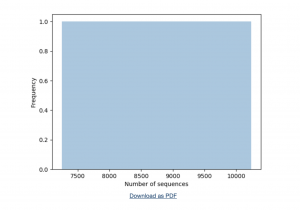Lab 13: Soil eDNA and Qiime2 Analysis
Sydney Ortenberg
April 19, 2019
Lab 13: Soil eDNA and Qiime2 Analysis
Purpose/Objective:
The objective of this lab was to go through all the code and successfully download it to our computers. The purpose of this lab was to use qiime once again to understand its functions and obtain the visualizations from it. The data we used was all of the data that was collected from cili-cure the previous year.
Procedures:
- ensure that qiime 2 is downloaded on computer and if not, redownload it.
- Download the folder in the powerpoint from the module.
- Activate QIIME 2 in the terminal by typing “source activate qiime2-2019.1
- use the walkthrough document and copy and paste all the code as listed below:
Importing sequences as QIIME2 artifact:
qiime tools import \
–type EMPPairedEndSequences \
–input-path emp-paired-end-sequences \
–output-path emp-paired-end-sequences.qza
Demultiplexing sequences:
qiime demux emp-paired \
–m-barcodes-file sample-metadata.tsv \
–m-barcodes-column BarcodeSequence \
–i-seqs emp-paired-end-sequences.qza \
–o-per-sample-sequences demux.qza \
qiime demux summarize \
–i-data demux.qza \
–o-visualization demux.qzv
Denoising using DADA2 and creating a feature table with Representative sequences:
qiime dada2 denoise-paired \
–i-demultiplexed-seqs demux.qza \
–p-trunc-len-f 220 \
–p-trunc-len-r 220 \
–o-table table.qza \
–o-representative-sequences rep-seqs.qza \
–o-denoising-stats denoising-stats.qza
qiime feature-table summarize \
–i-table table.qza \
–o-visualization table.qzv \
–m-sample-metadata-file sample-metadata.tsv
qiime feature-table tabulate-seqs \
–i-data rep-seqs.qza \
–o-visualization rep-seqs.qzv
qiime metadata tabulate \
–m-input-file denoising-stats.qza \
–o-visualization denoising-stats.qzv
Creating a phylogenetic tree:
qiime phylogeny align-to-tree-mafft-fasttree \
–i-sequences rep-seqs.qza \
–o-alignment aligned-rep-seqs.qza \
–o-masked-alignment masked-aligned-rep-seqs.qza \
–o-tree unrooted-tree.qza \
–o-rooted-tree rooted-tree.qza
Taxonomic classification:
qiime feature-classifier classify-sklearn –i-classifier silva-132-99-515-806-nb-classifier.qza –i-reads rep-seqs.qza –o-classification taxonomy.qza
qiime metadata tabulate \
–m-input-file taxonomy.qza \
–o-visualization taxonomy.qzv
qiime taxa barplot \
–i-table table.qza \
–i-taxonomy taxonomy.qza \
–m-metadata-file sample-metadata.tsv \
–o-visualization taxa-bar-plots.qzv
**Note: Any time a .qzv was entered, the file was dragged and dropped into the view qiime 2 website.
Data:
Storage:
N/A since in computer lab
Conclusion and Future Steps:
The purpose of this lab was to use qiime once again and grasp more knowledge of it before we sequence our own DNA. We went through several steps and we were able to make a phylogenetic tree and compare the powersoil eDNA and the Chelex eDNA. We were able to see the abundance of the different soil types and use the visualizations to understand the data. In the future, I am looking forward to using qiime to metabarcode our findings and us the databse to compare it to other V4 regions.




